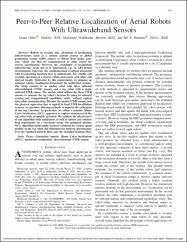| dc.contributor.author | Guler, Samet | |
| dc.contributor.author | Abdelkader, Mohamed | |
| dc.contributor.author | Shamma, Jeff S. | |
| dc.date.accessioned | 2022-02-17T07:36:00Z | |
| dc.date.available | 2022-02-17T07:36:00Z | |
| dc.date.issued | 2021 | en_US |
| dc.identifier.issn | 1063-6536 | |
| dc.identifier.issn | 1558-0865 | |
| dc.identifier.uri | https //doi.org/10.1109/TCST.2020.3027627 | |
| dc.identifier.uri | https://hdl.handle.net/20.500.12573/1158 | |
| dc.description | This work was supported by the King Abdullah University of Science and Technology (KAUST). The work of Samet Guler was also supported by the TUB.ITAK 2232 International Fellowship for Outstanding Researchers Program. | en_US |
| dc.description.abstract | Robots in swarms take advantage of localization infrastructure, such as a motion capture system or global positioning system (GPS) sensors to obtain their global position, which can then be communicated to other robots for swarm coordination. However, the availability of localization infrastructure needs not to be guaranteed, e.g., in GPS-denied environments. Likewise, the communication overhead associated with broadcasting locations may be undesirable. For reliable and versatile operation in a swarm, robots must sense each other and interact locally. Motivated by this requirement, we propose an onboard relative localization framework for multirobot systems. The setup consists of an anchor robot with three onboard ultrawideband (UWB) sensors and a tag robot with a single onboard UWB sensor. The anchor robot utilizes the three UWB sensors to estimate the tag robot's location by using its onboard sensing and computational capabilities solely, without explicit interrobot communication. Because the anchor UWB sensors lack the physical separation that is typical in fixed UWB localization systems, we introduce filtering methods to improve the estimation of the tag's location. In particular, we utilize a mixture Monte Carlo localization (MCL) approach to capture maneuvers of the tag robot with acceptable precision. We validate the effectiveness of our algorithm with simulations as well as indoor and outdoor field experiments on a two-drone setup. The proposed mixture MCL algorithm yields highly accurate estimates for various speed profiles of the tag robot and demonstrates superior performance over the standard particle filter and the extended Kalman filter. | en_US |
| dc.description.sponsorship | King Abdullah University of Science & Technology
TUB.ITAK 2232 International Fellowship for Outstanding Researchers Program | en_US |
| dc.language.iso | eng | en_US |
| dc.publisher | IEEE-INST ELECTRICAL ELECTRONICS ENGINEERS INC445 HOES LANE, PISCATAWAY, NJ 08855-4141 | en_US |
| dc.relation.isversionof | 10.1109/TCST.2020.3027627 | en_US |
| dc.rights | info:eu-repo/semantics/openAccess | en_US |
| dc.subject | Robot sensing systems | en_US |
| dc.subject | Robot kinematics | en_US |
| dc.subject | Mobile robots | en_US |
| dc.subject | Global Positioning System | en_US |
| dc.subject | Multi-robot systems | en_US |
| dc.subject | Formation control | en_US |
| dc.subject | Monte Carlo localization (MCL) | en_US |
| dc.subject | multirobot localization | en_US |
| dc.subject | ultrawideband (UWB) sensor | en_US |
| dc.title | Peer-to-Peer Relative Localization of Aerial Robots With Ultrawideband Sensors | en_US |
| dc.type | article | en_US |
| dc.contributor.department | AGÜ, Mühendislik Fakültesi, Elektrik - Elektronik Mühendisliği Bölümü | en_US |
| dc.contributor.authorID | 0000-0002-9870-166X | en_US |
| dc.contributor.institutionauthor | Guler, Samet | |
| dc.identifier.volume | Volume 29 Issue 5 Page 1981-1996 | en_US |
| dc.relation.journal | IEEE TRANSACTIONS ON CONTROL SYSTEMS TECHNOLOGY | en_US |
| dc.relation.publicationcategory | Makale - Uluslararası - Editör Denetimli Dergi | en_US |


















